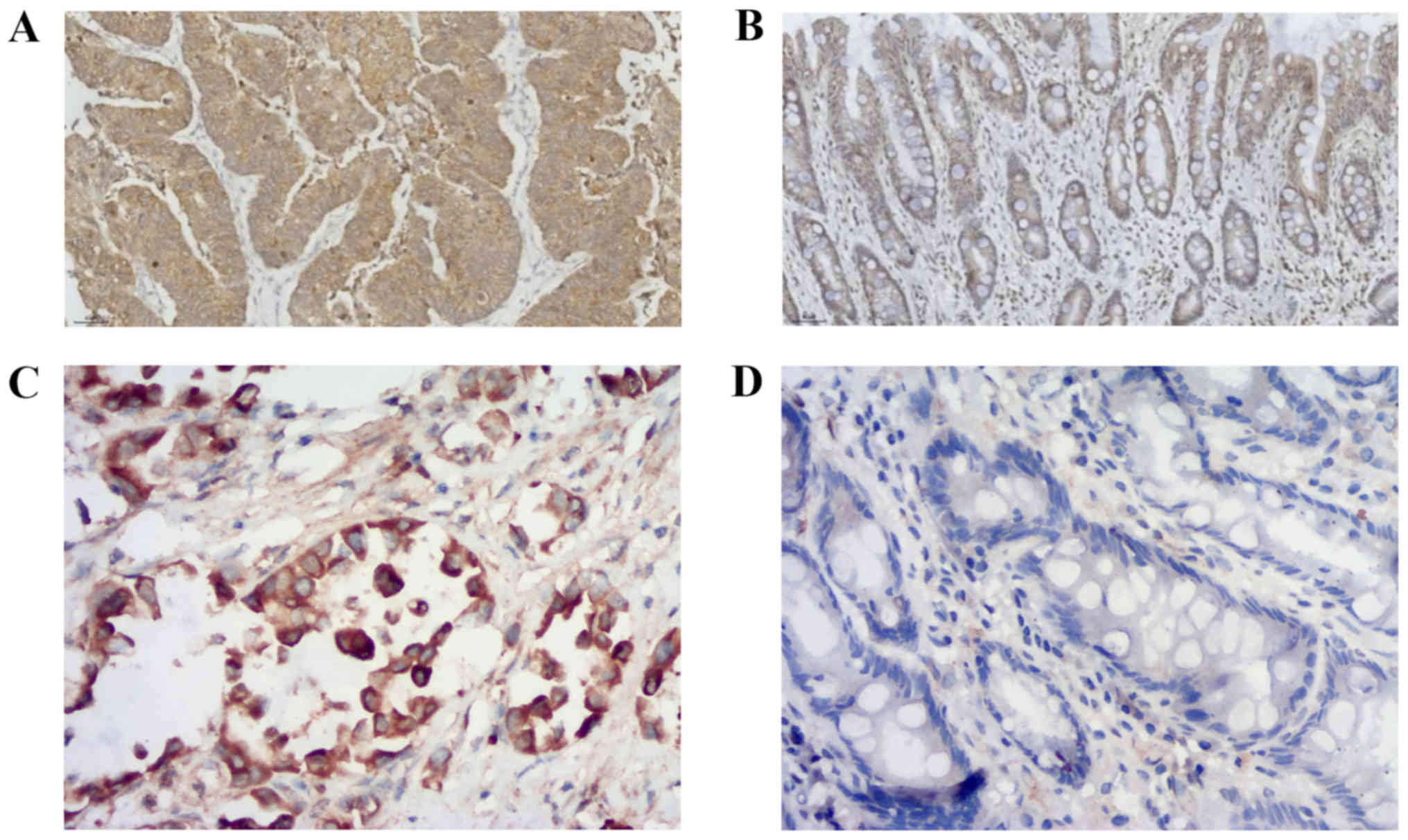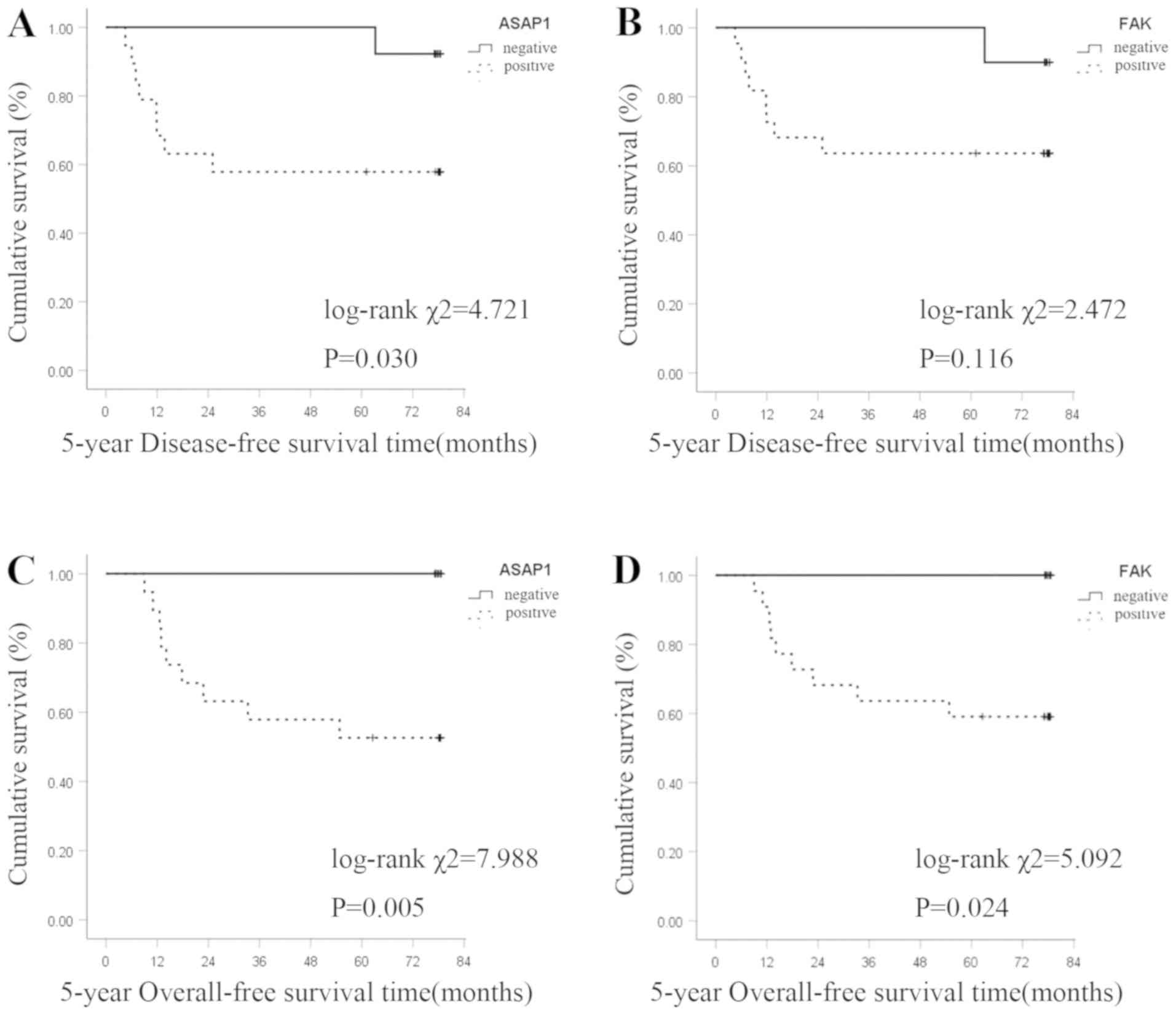|
1
|
Ferlay J, Soerjomataram I, Dikshit R, Eser
S, Mathers C, Rebelo M, Parkin DM, Forman D and Bray F: Cancer
incidence and mortality worldwide: Sources, methods and major
patterns in GLOBOCAN 2012. Int J Cancer. 136:E359–E386. 2015.
View Article : Google Scholar : PubMed/NCBI
|
|
2
|
Li J, Meng Q, Sun Y and Qing H: Inhibition
of focal adhesion kinase induces apoptosis in human gastric
carcinoma cells (SGC-7901). Mol Biol Rep. 40:401–406. 2013.
View Article : Google Scholar : PubMed/NCBI
|
|
3
|
Li Z, Lei H, Luo M, Wang Y, Dong L, Ma Y,
Liu C, Song W, Wang F, Zhang J, et al: DNA methylation
downregulated mir-10b acts as a tumor suppressor in gastric cancer.
Gastric Cancer. 18:43–54. 2015. View Article : Google Scholar : PubMed/NCBI
|
|
4
|
Kanda M and Kodera Y: Recent advances in
the molecular diagnostics of gastric cancer. World J Gastroenterol.
21:98382015. View Article : Google Scholar : PubMed/NCBI
|
|
5
|
Hou T, Yang C, Tong C, Zhang H, Xiao J and
Li J: Overexpression of ASAP1 is associated with poor prognosis in
epithelial ovarian cancer. Int J Clin Exp Pathol.
7:2802014.PubMed/NCBI
|
|
6
|
Zhang L, Shi SB, Zhu Y, Qian TT and Wang
HL: Long non-coding RNA ASAP1-IT1 promotes cell proliferation,
invasion and metastasis through the PTEN/AKT signaling axis in
non-small cell lung cancer. Eur Rev Med Pharmacol Sci. 22:142–149.
2018.PubMed/NCBI
|
|
7
|
Randazzo PA, Inoue H and Bharti S: Arf
GAPs as regulators of the actin cytoskeleton. Biol Cell.
99:583–600. 2007. View Article : Google Scholar : PubMed/NCBI
|
|
8
|
Zhang T, Zhao G, Yang C, Dong P, Watari H,
Zeng L, Pfeffer LM and Yue J: Lentiviral vector mediated-ASAP1
expression promotes epithelial to mesenchymal transition in ovarian
cancer cells. Oncol Lett. 15:4432–4438. 2018.PubMed/NCBI
|
|
9
|
Yang L, Xue Y, Liu J, Zhuang J, Shen L,
Shen B, Yan J and Guo H: Long noncoding RNA ASAP1-IT1 promotes
cancer stemness and predicts a poor prognosis in patients with
bladder cancer. Neoplasma. 64:847–855. 2017. View Article : Google Scholar : PubMed/NCBI
|
|
10
|
Sulzmaier FJ, Jean C and Schlaepfer DD:
FAK in cancer: Mechanistic findings and clinical applications. Nat
Rev Cancer. 14:5982014. View
Article : Google Scholar : PubMed/NCBI
|
|
11
|
Fan H, Zhao X, Sun S, Luo M and Guan JL:
Function of focal adhesion kinase scaffolding to mediate endophilin
A2 phosphorylation promotes epithelial-mesenchymal transition and
mammary cancer stem cell activities in vivo. J Biol Chem.
288:3322–3333. 2013. View Article : Google Scholar : PubMed/NCBI
|
|
12
|
Fu W, Hall JE and Schaller MD: Focal
adhesion kinase-regulated signaling events in human cancer. Biomol
Concepts. 3:225–240. 2012. View Article : Google Scholar : PubMed/NCBI
|
|
13
|
Thanapprapasr D, Previs RA, Hu W, Ivan C,
Armaiz-Pena GN, Dorniak PL, Hansen JM, Rupaimoole R, Huang J,
Dalton HJ, et al: PTEN expression as a predictor of response to
focal adhesion kinase inhibition in uterine cancer. Mol Cancer
Ther. 14:1466–1475. 2015. View Article : Google Scholar : PubMed/NCBI
|
|
14
|
Zeng XQ, Li N, Ma LL, Tseng YJ, Zhao NQ
and Chen SY: Prognostic value of focal adhesion kinase (FAK) in
human solid carcinomas: A meta-analysis. PLoS One. 11:e01626662016.
View Article : Google Scholar : PubMed/NCBI
|
|
15
|
Sobin L: International Union Against
Cancer (UICC) TNM classification of malignant tumours. Oesophagus
including Oesophagogastric Junction. 66–72. 2009.
|
|
16
|
Buqué A, Bloy N, Aranda F, Castoldi F,
Eggermont A, Cremer I, Fridman WH, Fucikova J, Galon J, Marabelle
A, et al: Trial watch: Immunomodulatory monoclonal antibodies for
oncological indications. Oncoimmunology. 4:e10088142015. View Article : Google Scholar : PubMed/NCBI
|
|
17
|
Petrelli NJ, Winer EP, Brahmer J, Dubey S,
Smith S, Thomas C, Vahdat LT, Obel J, Vogelzang N, Markman M, et
al: Clinical Cancer Advances 2009: Major research advances in
cancer treatment, prevention, and screening-a report from the
American Society of Clinical Oncology. J Clin Oncol. 27:6052–6069.
2009. View Article : Google Scholar : PubMed/NCBI
|
|
18
|
Yazici O, Sendur MA, Ozdemir N and Aksoy
S: Targeted therapies in gastric cancer and future perspectives.
World J Gastroenterol. 22:471–489. 2016. View Article : Google Scholar : PubMed/NCBI
|
|
19
|
Feng R, Zhang X and Yang S: Research
status quo and progression in targeted therapy for advanced gastric
cancer. Zhonghua Wei Chang Wai Ke Za Zhi. 19:1191–1196. 2016.(In
Chinese). PubMed/NCBI
|
|
20
|
Müller T, Stein U, Poletti A, Garzia L,
Rothley M, Plaumann D, Thiele W, Bauer M, Galasso A, Schlag P, et
al: ASAP1 promotes tumor cell motility and invasiveness, stimulates
metastasis formation in vivo, and correlates with poor survival in
colorectal cancer patients. Oncogene. 29:2393–2403. 2010.
View Article : Google Scholar : PubMed/NCBI
|
|
21
|
Randazzo PA, Andrade J, Miura K, Brown MT,
Long YQ, Stauffer S, Roller P and Cooper JA: The Arf
GTPase-activating protein ASAP1 regulates the actin cytoskeleton.
Proc Natl Acad Sci USA. 97:4011–4016. 2000. View Article : Google Scholar : PubMed/NCBI
|
|
22
|
Liu Y, Yerushalmi GM, Grigera PR and
Parsons JT: Mislocalization or reduced expression of Arf
GTPase-activating protein ASAP1 inhibits cell spreading and
migration by influencing Arf1 GTPase cycling. J Biol Chem.
280:8884–8892. 2005. View Article : Google Scholar : PubMed/NCBI
|
|
23
|
Inoue H and Randazzo PA: Arf GAPs and
their interacting proteins. Traffic. 8:1465–1475. 2007. View Article : Google Scholar : PubMed/NCBI
|
|
24
|
Nie Z and Randazzo PA: Arf GAPs and
membrane traffic. J Cell Sci. 119:1203–1211. 2006. View Article : Google Scholar : PubMed/NCBI
|
|
25
|
Brown MT, Andrade J, Radhakrishna H,
Donaldson JG, Cooper JA and Randazzo PA: ASAP1, a
phospholipid-dependent arf GTPase-activating protein that
associates with and is phosphorylated by Src. Mol Cell Biol.
18:7038–7051. 1998. View Article : Google Scholar : PubMed/NCBI
|
|
26
|
Kowanetz K, Husnjak K, Höller D, Kowanetz
M, Soubeyran P, Hirsch D, Schmidt MHH, Pavelic K, De Camilli P,
Randazzo PA and Dikic I: CIN85 associates with multiple effectors
controlling intracellular trafficking of epidermal growth factor
receptors. Mol Biol Cell. 15:3155–3166. 2004. View Article : Google Scholar : PubMed/NCBI
|
|
27
|
Oda A, Wada I, Miura K, Okawa K, Kadoya T,
Kato T, Nishihara H, Maeda M, Tanaka S, Nagashima K, et al: CrkL
directs ASAP1 to peripheral focal adhesions. J Biol Chem.
278:6456–6460. 2003. View Article : Google Scholar : PubMed/NCBI
|
|
28
|
Liu Y, Loijens JC, Martin KH, Karginov AV
and Parsons JT: The association of ASAP1, an ADP ribosylation
factor-GTPase activating protein, with focal adhesion kinase
contributes to the process of focal adhesion assembly. Mol Biol
Cell. 13:2147–2156. 2002. View Article : Google Scholar : PubMed/NCBI
|
|
29
|
Schaller MD, Hildebrand JD and Parsons JT:
Complex formation with focal adhesion kinase: A mechanism to
regulate activity and subcellular localization of Src kinases. Mol
Biol Cell. 10:3489–3505. 1999. View Article : Google Scholar : PubMed/NCBI
|
|
30
|
Weiner TM, Craven RJ, Craven RJ and Cance
WG: Expression of focal adhesion kinase gene and invasive cancer.
Lancet. 342:1024–1025. 1993. View Article : Google Scholar : PubMed/NCBI
|
|
31
|
Miyazaki T, Kato H, Nakajima M, Sohda M,
Fukai Y, Masuda N, Manda R, Fukuchi M, Tsukada K and Kuwano H: FAK
overexpression is correlated with tumour invasiveness and lymph
node metastasis in oesophageal squamous cell carcinoma. Br J
Cancer. 89:1402003. View Article : Google Scholar : PubMed/NCBI
|
|
32
|
Park JH, Lee BL, Yoon J, Kim J, Kim MA,
Yang HK and Kim WH: Focal adhesion kinase (FAK) gene amplification
and its clinical implications in gastric cancer. Hum Pathol.
41:1664–1673. 2010. View Article : Google Scholar : PubMed/NCBI
|
|
33
|
Lai HC, Zhuang LF, Liu X, Wieland M and
Zhang ZY and Zhang ZY: The influence of surface energy on early
adherent events of osteoblast on titanium substrates. J Biomed
Mater Res A. 93:289–296. 2010.PubMed/NCBI
|
|
34
|
Wang J, Wen T, Li Z, Che X, Gong L, Yang
X, Zhang J, Tang H, He L, Qu X and Liu Y: MicroRNA-1224 inhibits
tumor metastasis in intestinal-type gastric cancer by directly
targeting FAK. Front Oncol. 9:2222019. View Article : Google Scholar : PubMed/NCBI
|
|
35
|
Yoon HY, Jacques K, Nealon B, Stauffer S,
Premont RT and Randazzo P: Differences between AGAP1, ASAP1 and Arf
GAP1 in substrate recognition: Interaction with the N-terminus of
Arf1. Cell Signal. 16:1033–1044. 2004. View Article : Google Scholar : PubMed/NCBI
|
|
36
|
Vitali T, Girald-Berlingeri S, Randazzo PA
and Chen PW: Arf GAPs: A family of proteins with disparate
functions that converge on a common structure, the integrin
adhesion complex. Small GTPases. 10:280–288. 2019.PubMed/NCBI
|
|
37
|
Brami-Cherrier K, Gervasi N, Arsenieva D,
Walkiewicz K, Boutterin MC, Ortega A, Leonard PG, Seantier B, Gasmi
L, Bouceba T, et al: FAK dimerization controls its kinase-dependent
functions at focal adhesions. EMBO J. 33:356–370. 2014. View Article : Google Scholar : PubMed/NCBI
|
















